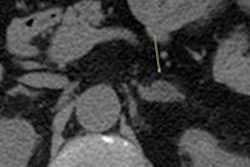Both CT and MRI can help in the detection of unknown adrenal incidentalomas, according to a study published online by the eBoutique of the French Society of Radiology (SFR).
Adrenal incidentalomas are found in 5% to 10% of abdominal CT scans, which are performed in cases of other suspected abnormalities or conditions, such as adrenal adenoma. Fortunately for patients, most of these lesions are benign and not considered cancerous.
MRI is often used as a second option to determine etiology and provide additional diagnostic information on unknown masses. In particular, MR imaging sequences, such as fat saturation and T2-weighted imaging with or without contrast, help lead to a diagnosis.
Imaging findings sometimes lead to a more rare, but misleading, pathology of pheochromocytoma or to a suspected malignancy of corticosteroidal adenoma or a metastasis.
"The management recommendations must be proposed according to the character function of the lesion, and the signs collected by CT and/or MRI," wrote the lead author Dr. Paul Legmann, head of the radiology department at Cochin Hospial Paris.



















